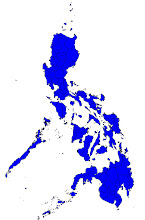from Philippine Daily Inquirer
http://newsinfo.inquirer.net/inquirerheadlines/nation/view/20100310-257739/When-a-tie-is-not-really-a-tieMANILA, Philippines—“When our report comes out, you will see that we just say it’s a 2-point lead and we’re not calling it a tie. Now the reason I say that is because if it could be a zero lead, it could also be a 4-point lead. It could really range to as high as four. But we’re not saying that. It seems to me that the neutral thing to do is to call it as two, because that’s where it is centered. And if you go to emphasize the tie, you’re really leaning on one side,” Mahar Mangahas, president of Social Weather Stations, says in an interview on ANC.
“I’m saying it’s a statistical tie, but it’s also a statistical 4-point lead. You’re biased if you only go to the low side, not also to the high side. You have to look at everything. Let’s not insist on saying that it’s zero, because it can also be four. To me, that’s the error. Analysts are rushing to say that finally, it’s a tie. It’s not yet a tie.”
Margin of error
“This is not the first time that Noynoy Aquino and Manny Villar have come to a “statistical tie.” In the Jan. 22-26 Pulse Asia survey, both were “tied” if the margin of error was factored in,” says Ana Maria Tabunda, Pulse Asia chief research fellow.
“The latest survey results of Pulse Asia and SWS may be different, but it does not mean they are inconsistent.
“Both are scientifically done, but we have to factor in the difference in the survey period (the recent Pulse Asia survey was conducted on Feb. 21 to 25, while SWS conducted its survey on Feb. 24 to 28).
“We should also take note of the difference in sample size—Pulse Asia has a smaller sample (1,800 respondents) compared to SWS’ (2,100 respondents), because of prohibitive costs.”
AP Stylebook
The Associated Press Stylebook on polls and surveys says: “When writing and editing poll stories, here are areas for close attention.
“Do not exaggerate poll results. In particular, with pre-election polls, these are the rules for deciding when to write that the poll finds one candidate is leading another.
“If the difference between the candidates is more than twice the sampling error margin, then the poll says one candidate is leading.
“If the difference is less than the sampling error margin, the poll says that the race is close, that the candidates are “about even.”
“If the difference is at least equal to the sampling error but no more than twice the sampling error, then one candidate can be said to be ‘apparently leading’ or ‘slightly ahead’ in the race.”
Despite discrepancies
“Surveys have basis despite the discrepancies. We think the survey results tell politicians where to go in their campaigns. Even if the survey results are different, they are still important because it is indicated there which areas they should work on. Though we think the results will be different by May, in the end this depends on the campaign efforts of the candidates,” says Andie Lasala, national coordinator, Bantay Eleksyon 2010, a coalition of electoral stakeholders formed by the Consortium on Electoral Reforms (CER), a group of 47 electoral reform organizations.
Villar’s decline noticeable
“Rumors that Villar is the administration’s secret candidate will have a negative impact on Villar in the long run. Depending on events, Villar may score lower in the next survey rounds, should people be more convinced that he is the administration’s bet.
“Also, one of the more interesting things to look at in the latest Pulse Asia survey is how Aquino registered a decline of one point, and how Villar lost 6 percentage points. The gap between Villar and Aquino may be dwindling, but Villar’s decline is more noticeable. It’s also good to look at Joseph Estrada’s 6-point rise, but we are not wary of that.
“We don’t think Erap can affect the fact that it’s still a race between Aquino and Villar come Election Day.” Compiled by Inquirer Research




No comments:
Post a Comment